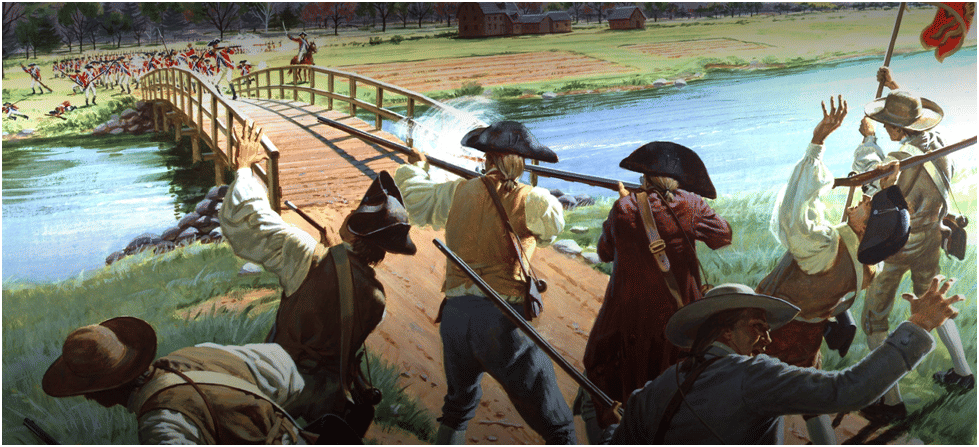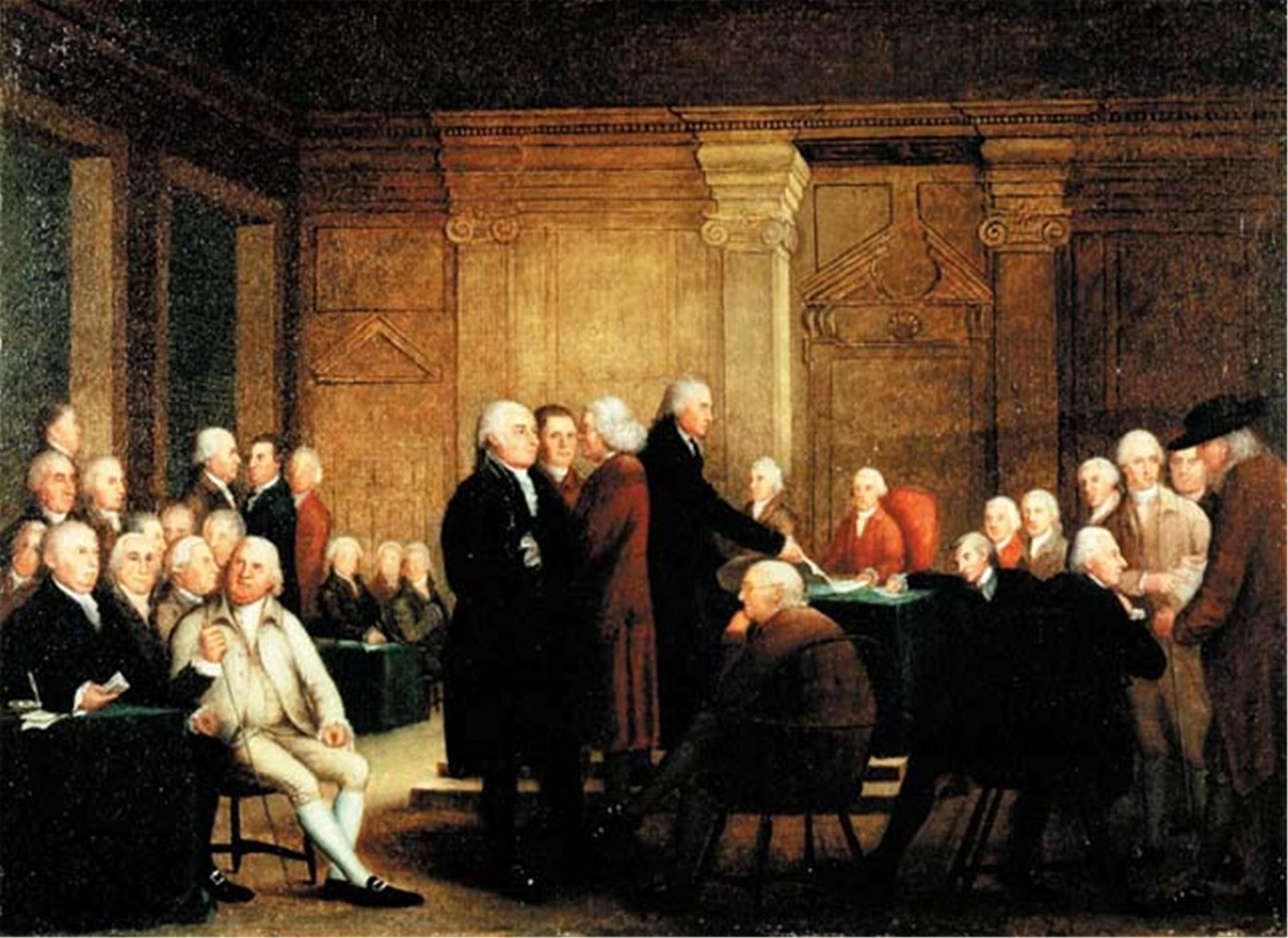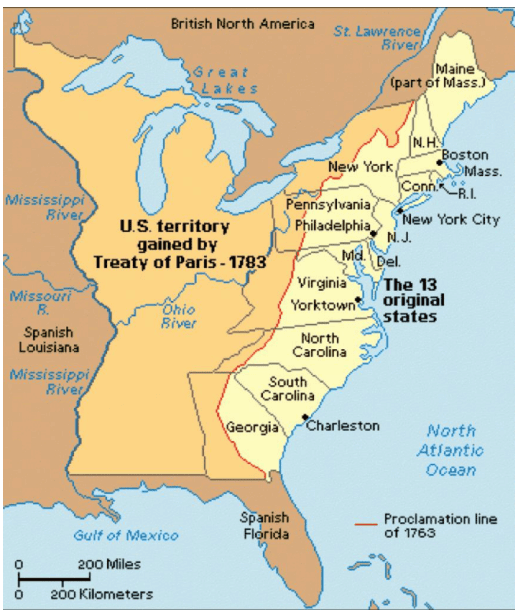Causes of the American Revolution | History Optional for UPSC PDF Download
Some other factors which led to American Revolution

America’s independent way of thinking
Geographic Considerations:
- The vast distance between the colonies and Great Britain fostered a sense of independence that was difficult to suppress.
- Those who chose to settle in the New World often possessed a strong independent spirit, seeking new opportunities and greater freedom.
Colonial Legislatures:
- The presence of colonial legislatures granted the colonies a degree of independence from the Crown.
- These legislatures had the authority to impose taxes, raise troops, and enact laws. Over time, these powers were seen as rights by many colonists.
- When the British curtailed these powers, it led to conflicts. Many future leaders of the United States emerged from these legislatures.
Defective Administrative System:
- The Governor and Executive Council were accountable to the Emperor, but the legislative assembly primarily handled legislation and tax imposition.
- This allowed the legislative assembly to reject demands for payment from Governors and judges.
Salutary Neglect:
- Despite British beliefs in mercantilism, Prime Minister Robert Walpole advocated for “salutary neglect,” a system of lax enforcement of external trade relations.
- Walpole believed that this approach would stimulate commerce by enhancing freedom.
The Enlightenment:
- Many revolutionary leaders were influenced by Enlightenment thinkers such as Thomas Hobbes, John Locke, Jean-Jacques Rousseau, and Montesquieu.
- They derived concepts like the social contract, limited government, consent of the governed, and separation of powers from these writings.
Trade:
- The establishment of Triangular Trade routes forced Americans to trade abundant goods for scarce ones.
- Triangular Trade, along with British mercantilism, created a “favorable balance of trade” for Great Britain, ensuring that gold, silver, and domestic currency remained in England.
- Several Acts were enacted that hindered American exports, such as the Wool Act (1699), Hat Act (1732), and Iron Act (1750), which restricted the export of American-made goods.
Beginning of the Revolution
After the Quebec Act was passed, the Americans began to organize militias and prepare for war. In response, the British restricted trade for the New England colonies to only Britain and barred them from the Newfoundland fisheries. British Prime Minister Lord North proposed a compromise where Parliament would not impose taxes as long as the colonies made fixed contributions for defense and civil government support. This proposal was also rejected.
- 16 June, 1775: The Continental Congress appointed George Washington as the commander-in-chief of the Continental Army and issued $2 million in bills of credit to fund the army.
- 19 April, 1775: The Battles of Lexington and Concord marked the first conflict between British troops and American militia. The Patriots besieged Boston, expelled royal officials from all the colonies, and took control by establishing Provincial Congresses.
- 17 June, 1775: The Battle of Bunker Hill was the first major battle of the War of Independence.
Creating new state constitutions
Following the Battle of Bunker Hill
After the Battle of Bunker Hill in June 1775, the Patriots gained control of Massachusetts outside of Boston. The Loyalists found themselves on the defensive without protection from the British army. Across all 13 colonies, Patriots had overthrown existing governments, closing courts and driving out British officials.
- They established new conventions and legislatures, using new constitutions to replace royal charters.
- They declared themselves states, not colonies.
- On January 5, 1776, New Hampshire ratified the first state constitution, followed by Virginia, South Carolina, New Jersey, Rhode Island, and Connecticut.
- In April 1776, the North Carolina Provincial Congress authorized its delegates to vote for independence.
- In May 1776, Congress voted to abolish all forms of crown authority, replaced by locally created authority, and called on all states to draft their own constitutions.
- The new states were committed to republicanism, with no inherited offices.
In states where the wealthy exerted firm control
- Property qualifications for voting
- Bicameral legislatures, with the upper house checking the lower
- Strong governors, with veto power over the legislature
- Continuation of state-established religion
In states where the less affluent had significant power
- Universal white manhood suffrage, or minimal property requirements for voting
- Strong, unicameral legislatures
- Relatively weak governors, without veto powers
- Prohibition against individuals holding multiple government posts
Thomas Paine's Common Sense (Published on January 9, 1776)
- It is ironic that Thomas Paine, an emigrant from the lower classes of England who arrived in America in 1774, recognized that America could be a "sanctuary of freedom for humanity."
- Among the pamphlets and documents from 1775 to 1776, Common Sense emerged as the most widely read and influential.
- This 47-page pamphlet sold 120,000 copies in just three months, with around 500,000 copies sold throughout 1776.
- Paine argued that Americans should reject the "monarchial tyranny" of the King and the "aristocratical tyranny" of Parliament, advocating for independent republican states.
- He found it absurd that a small island like Britain could rule over the vast continent of America.
- Common Sense played a crucial role in promoting republicanism and liberalism, fueling enthusiasm for separation from Britain and encouraging recruitment for the Continental Army.
- The pamphlet reflects Paine's revolutionary idealism and free thinking.
- Reportedly, George Washington was so influenced by Paine's arguments that he decided to withdraw his support for the King of England.
The Second Continental Congress

- When and Where: The Second Continental Congress was held in Philadelphia, Pennsylvania, starting in the summer of 1775, shortly after the American Revolutionary War had begun.
- Successor to First Continental Congress: It followed the First Continental Congress, which took place from September 5 to October 26, 1774, also in Philadelphia.
- Role and Actions: The Second Continental Congress managed the colonial war effort and gradually moved towards independence by:
- Raising armies
- Directing military strategy
- Appointing diplomats
- Making formal treaties
Olive-Branch Petition (5 July, 1775)
- Adoption: The Olive Branch Petition was adopted by the Second Continental Congress on July 5, 1775, as a last effort to prevent full-scale war between the Thirteen Colonies and Great Britain.
- Content: The petition expressed American loyalty to Great Britain and urged the king to prevent further conflict by recognizing American rights and ending the Intolerable Acts in exchange for a ceasefire.
- King's Response: Despite the Congress's attempt to mend relations, King George III refused to consider the petition. Instead, he issued the Proclamation of Rebellion and declared the colonies in open rebellion on August 23, 1775.
- Shift in Congress: By June 1776, Loyalists and moderates opposed to independence left the Continental Congress, allowing Patriots to take full control. The Congress then appointed a committee led by Thomas Jefferson to draft the Declaration of Independence.
Declaration of Independence (4 July, 1776)
- The Declaration of Independence was a document approved by the Continental Congress in Philadelphia on July 4, 1776, proclaiming the separation of 13 North American British colonies from Great Britain.
- Primarily written by Thomas Jefferson, who had previously shown his skills in political writing.
- The document outlined the reasons for seeking independence, listing grievances against King George III and asserting natural rights, including the right to revolution.
- It explained the Congress's unanimous decision on July 2 that the colonies had the right to be free and independent states.
- Before the declaration, colonists fought for their rights as subjects of Britain; afterward, they fought for independence as a nation.
- The Declaration accused the King of“repeated injuries and usurpations,”such as dissolving colonial governments, controlling judges, sending occupying armies, cutting off trade, and taxing without consent.
- It emphasized that “all men are created equal” and have inalienable rights to life, liberty, and the pursuit of happiness.
- If a government fails to protect these rights, it is the people’s right and duty to overthrow it and establish a new government to protect those rights.
- The phrase “Life, Liberty, and the pursuit of Happiness” was influenced by British philosopher John Locke, who argued that government exists to protect individuals’ rights to life, liberty, and property.
The Significance of the Declaration of Independence
- Abraham Lincoln viewed the Declaration as the core of his political beliefs, seeing it as a guiding principle for interpreting the U.S. Constitution. It played a role in the fight against slavery in the United States.
- The Declaration of Independence inspired various similar documents both within the United States and in other countries around the world.
- The Fifth and Fourteenth Amendments of the U.S. Constitution emphasize that no individual can be deprived of "life, liberty, or property" without due process of law.
- It acted as a fundamental example for numerous declarations of independence throughout Europe, Latin America, and Africa (notably Liberia) in the early 19th century.
- The Declaration motivated figures like Antonio de Nariño and Francisco de Miranda in their efforts to challenge the Spanish Empire in South America.
- Article 3 of the Universal Declaration of Human Rights states, "Everyone has the right to life, liberty, and security of person," reflecting principles found in the Declaration.
- Many leaders involved in the French Revolution held the Declaration of Independence in high regard.
- The French Declaration of the Rights of Man and Citizen (1789) was significantly influenced by the ideals of the American Revolution, with key contributions from Lafayette and Thomas Jefferson.
- During the French Revolution, the Marquis de Mirabeau enthusiastically cited the Declaration of Independence.
- The Declaration stands as a historic milestone for being the first formal assertion by a people of their right to self-governance. What John Locke argued for individuals, the Americans proclaimed collectively, backed by military force.
- Its impact is still felt today, contributing to the equality of women and the fair treatment of all races.
- Many civil rights advancements may not have occurred without the foundational words of the American founding fathers.
Articles of Confederation (1777–1781)
- On November 15, 1777, the Second Continental Congress approved a new constitution called the "Articles of Confederation," which was sent for ratification by the states.
- The Articles were officially ratified on March 1, 1781. At that point, the Continental Congress was dissolved, and a new government called the "United States in Congress assembled" was established, with Samuel Huntington as the presiding officer.
- The Articles of Confederation served as the written document that outlined the functions of the national government of the United States after it gained independence from Great Britain. It established a weak central government that primarily, but not entirely, restricted individual states from engaging in their own foreign diplomacy.
Outside Help for Americans
- In 1778, the Patriots' chances of winning improved.
- The victory of American militia against a trained British force boosted American confidence. The French government decided to assist the colonies with troops, supplies, and funds to embarrass Britain, France's old enemy. Other British adversaries, Spain and Holland, also engaged the British elsewhere.
- The alliance provided the Americans with money, troops, and supplies, transforming the conflict from a colonial rebellion into an international war.
- British forces now had to confront troops in North America while also defending the West Indies and India against France and Gibraltar against Spain.
- Meanwhile, Britain faced domestic troubles with the threat of rebellion in Ireland and strong opposition to the war with the colonists in Parliament.
Yorktown 1781: Surrender of British Army
- The British army, led by Cornwallis, marched to Yorktown, Virginia, where they found themselves trapped. In October 1781, under a combined siege by the French and Continental armies led by Washington, the British surrendered.
- Although the British Army surrendered at Yorktown in October, it took diplomats two more years to finalize the peace. Peace talks began in 1782, but the French delayed, hoping for a naval victory or territorial gains. The British made strategic and tactical decisions that were deeply flawed, as they underestimated the challenges posed by the Patriots.
- Support for the conflict had never been strong in Britain, where many sympathized with the rebels. However, at this point, it reached a new low.
- Although King George III personally wanted to continue fighting, his supporters lost control of Parliament, and no further major land offensives were launched.
Peace of Paris (1783)
- The Peace of Paris, signed on September 3, 1783, marked the end of the American Revolutionary War through a series of treaties.
- Key figures like Benjamin Franklin, John Adams, and John Jay represented the United States in signing the Treaty of Paris, while separate treaties were made with France, Spain, and Holland.
- Treaty of Paris (1783): The main agreement that recognized the independence of the 13 American colonies and set new boundaries.
- Territorial Changes: Britain kept Canada but ceded land between the Appalachians and the Mississippi River to the United States.
- Loyalist Rights: The U.S. agreed to stop persecuting Loyalists and restore their confiscated properties.
- Prisoner Release: All war prisoners were to be released.
- Ratification: The American Congress ratified the treaty on January 14, 1784.
- Generosity of the Treaty: The treaty was seen as favorable to the U.S., granting it significant territorial expansion.
- Treaty of Versailles: Signed simultaneously, it marked peace between Britain, France, and Spain.
- French Gains: France gained territories like Saint Louis, Tobago, Senegal, and regions in India.
- Spanish Gains: Spain regained Florida from Britain and emerged from the war with significant territorial advantages.
- Boundary Vagueness: The treaties were unclear about boundaries, leading to disputes for the next 30 years.
- Indian Allies: The British abandoned their Indian allies in the region, who were not part of the treaty.
- Trade Freedom: Post-blockade, American merchants gained the freedom to trade globally, leading to business growth.


How the Wealth of Nations by Adam Smith influenced the course of the
Revolutionary War
- Published in 1776, "The Wealth of Nations" is considered one of the most influential works on market economics. Smith's research began in 1766 and focused on the British government's decision to tax colonists to help pay off war debt from the Seven Years War.
- Smith criticized the mercantilist system of 18th Century Europe, which aimed to increase exports while limiting imports to achieve a favorable balance of trade.
- He argued against the mercantilist belief that accumulating gold and silver equated to wealth, proposing instead that true wealth comes from the annual produce of a society's land and labor.
- Smith viewed the British colonial empire and its mercantile restrictions as detrimental to societal interests, benefiting only British special interests.
- He advocated for a free market system, where supply and demand operate with minimal government control, benefiting all social classes rather than just a privileged few.
- Smith proposed that the British should eliminate government economic privileges and restrictions, allowing the free market mechanism to function independently (laissez-faire).
- He suggested that the colonies, which had become more of a burden than a benefit to Britain, should be allowed to go their own way.
- Smith's ideas on free market economics significantly influenced American colonial leaders as they approached war with England.
|
367 videos|995 docs
|
FAQs on Causes of the American Revolution - History Optional for UPSC
| 1. What were some key factors that led to the American Revolution? |  |
| 2. How did Thomas Paine's "Common Sense" influence the American Revolution? |  |
| 3. What was the significance of the Second Continental Congress during the American Revolution? |  |
| 4. In what ways did Adam Smith's "The Wealth of Nations" influence the course of the Revolutionary War? |  |
| 5. How did the creation of new state constitutions impact the American Revolution? |  |
















